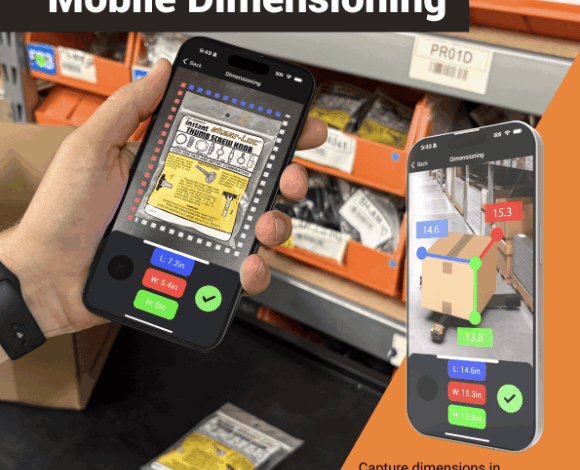
Introduction: AI Agents Are Only as Smart as Their Data
As enterprises embrace agentic AI—autonomous AI agents capable of planning, executing, and learning—one persistent challenge remains: the need for trusted, real-time data captured at the edge. In logistics and warehousing, if AI agents rely on outdated or estimated product data, their decisions can become misleading or inefficient.
Mobile dimensioning bridges this gap by enabling front-line capture of detailed product data—dimensions, weight, classification, images, barcodes—directly at the product’s location using mobile devices. This “last mile of data” becomes a critical input for AI agents powering automated workflows.
Why Mobile Dimensioning Makes AI Agents Effective
Recent MobileDemand research reveals that:
- Mobile workflows are 3× faster than fixed cubing stations
- Average cost per SKU is $1.32, versus $6+ for traditional methods
- Payback periods fall under three months in most cases
- Large-scale analysis covers over 70,000 SKU measurements SupplyChain247+1SupplyChain247+1parcelindustry.com
From a global AI strategy perspective, these figures are critical. According to Gartner, by 2030 nearly 50% of cross-functional supply chain systems will employ intelligent AI agents to autonomously execute decisions across planning and fulfillment processes Supply & Demand Chain Executive. And McKinsey observes that agentic AI, when fully integrated, shifts GenAI from reactive tools to proactive workflow collaborators McKinsey & Company.
But the success of these systems hinges on one thing: high-quality data pipelines. Clean, complete, edge-captured data enables AI agents to make precise slotting, packaging, load planning, and exception routing decisions in real-time.
How Mobile Dimensioning Empowers Workflow Automation
Accurate SKU Data at the Source
Devices like iPhone Pro, iPad Pro, and Windows rugged tablets capture rich product metadata—dimensions, photos, weights, barcodes—right at docks, shelves, or trucks. This ensures AI agents consume real-world facts rather than estimates, significantly reducing error rates.
Optimized Slotting & Storage
AI agents continuously realign warehouse layouts using live dimension data and demand velocity. Mobile dimensioning supports this by enabling quick remeasurement of new SKUs—boosting space utilization and reducing pick cycles.
Intelligent Load Planning
With real parcel and pallet dimensions, AI agents can optimize trailer loads and avoid carrier surcharges tied to inaccurate dimensional weight estimates. This leads to higher fill rates and lower freight spend. link
Dynamic Returns Management
Returned items can be dimensioned and imaged at the return facility. AI agents then decide in real time whether to refurbish, resell, or recycle—speeding up reverse logistics workflows and maximizing return value.
Edge AI Verification
As edge AI models grow more robust, mobile devices may execute anomaly detection or exception validation on the spot—without waiting for cloud round-trips. This enables autonomous error detection even in low- or no-connectivity environments.
Industry Context: AI Agents + Data Capture = ROI
The Broader AI-Agent Landscape
Gartner predicts that agentic AI will automate 50% of SCM decisions by 2030, making data pipelines critical infrastructure, not auxiliary support (link). The SAP CEO also confirmed at Davos that agentic AI systems are being rolled out to handle pricing, fulfillment, and logistical collaboration, yet noted that most customers lack foundational data infrastructure Axios.
ROI & Strategic Impact
Enterprise AI agents can deliver up to 6× ROI in early deployment phases; across time, long-term gains of 5–10× are common—driven by cost savings, scaling efficiency, and model learning (link). McKinsey notes agentic AI empowers organizations to shift from merely generating insights to orchestrating workflows end-to-end (link).
Mobile dimensioning directly supports this transformation by delivering clean, edge-captured data—reducing assumptions, minimizing rework, and cutting error costs. It effectively becomes the data pump fueling agentic automation engines.
Strategic Evaluation Framework: Accuracy · Accessibility · Actionability
Organizations implementing mobile dimensioning for AI-first workflows should assess solutions across three domains:
- Accuracy — Captures precise dimensions, weight, photos, and classification in real-world conditions
- Accessibility — Supports diverse device platforms like iPhone Pro, iPad Pro, and Windows rugged tablets, aligning with existing workflows
- Actionability — Ensures captured data is structured and integrated into AI pipelines (WMS, ERP, TMS) without manual intervention
Successful implementations also include rapid adoption via intuitive apps, robust offline functionality, and API connectors to AI orchestration platforms.
Use Cases: AI Agents Powered by Mobile Dimensioning
- Retail Distribution: Store clusters dimension pallet stacks via iPad Pro and feed AI agents that recommend reslotting and replenish faster moving SKUs.
- E-commerce Fulfillment: Delivery pickup agents use iPhones to rapidly dimension odd-sized parcels in the field. AI agents integrate data to automatically flag shipment discrepancies and calculate volumetric fees.
- Reverse Logistics: Returns are dimensioned and inspected on-site. AI agents automate routing—whether to restock, refurbish, or recycle—based on captured metadata, streamlining operations and reducing loss.
Conclusion: Trust at the Edge Is What Enables AI Agents to Excel
The rise of agentic AI in supply chain and logistics is accelerating. By 2030, nearly half of enterprise supply chain systems will operate autonomously via AI agents—but the effectiveness of this shift relies entirely on trusted data pipelines.
Mobile dimensioning solves the “last mile of data”, capturing rich product insights exactly where movement occurs. By deploying cross-platform solutions on iPhone Pro, iPad Pro, and Windows rugged tablets, organizations enable data capture that’s fast, accurate, and broadly deployable. This enables AI agents to perform with precision—driving reductions in cost, cycle time, and operational risk.
Investing in mobile dimensioning isn’t just an operational upgrade—it’s a strategic lever for AI-first automation, ROI-driven deployment, and future-proof resilience. For firms ready to move from experimental AI pilots to production-ready automation, edge data capture is the bridge—and mobile dimensioning is the bridge builder.





